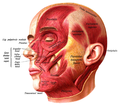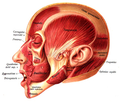The Muscles of the Nose: Difference between revisions
No edit summary |
No edit summary |
||
| (One intermediate revision by the same user not shown) | |||
| Line 7: | Line 7: | ||
The muscles of the nose (Fig. 378). comprise: | The muscles of the nose (Fig. 378). comprise: | ||
* Procerus. | |||
Procerus. | * Depressor septi. | ||
* Nasalis. | |||
Depressor septi. | * Dilatator naris posterior. | ||
* Dilatator naris anterior. | |||
Nasalis. | |||
Dilatator naris posterior. | |||
Dilatator naris anterior. | |||
=== '''Procerus''' === | === '''Procerus''' === | ||
Latest revision as of 15:09, 4 February 2025
Anatomy > Gray's Anatomy of the Human Body > IV. Myology > 4c. The Muscles of the Nose
Henry Gray (1821–1865). Anatomy of the Human Body. 1918.
The Muscles of the Nose[edit]
The muscles of the nose (Fig. 378). comprise:
- Procerus.
- Depressor septi.
- Nasalis.
- Dilatator naris posterior.
- Dilatator naris anterior.
Procerus[edit]
The Procerus (Pyramidalis nasi) is a small pyramidal slip arising by tendinous fibers from the fascia covering the lower part of the nasal bone and upper part of the lateral nasal cartilage; it is [inserted into the skin over the lower part of the forehead between the two eyebrows, its fibers decussating with those of the Frontalis.
Nasalis[edit]
The Nasalis (Compressor naris) consists of two parts, transverse and alar.
The transverse part arises from the maxilla, above and lateral to the incisive fossa; its fibers proceed upward and medialward, expanding into a thin aponeurosis which is continuous on the bridge of the nose with that of the muscle of the opposite side, and with the aponeurosis of the Procerus.
Alar part[edit]
The alar part is attached by one end to the greater alar cartilage, and by the other to the integument at the point of the nose.
Depressor septi[edit]
The Depressor septi (Depressor alœ nasi) arises from the incisive fossa of the maxilla; its fibers ascend to be inserted into the septum and back part of the ala of the nose. It lies between the mucous membrane and muscular structure of the lip.
Dilatator naris posterior[edit]
The Dilatator naris posterior is placed partly beneath the Quadratus labii superioris. It arises from the margin of the nasal notch of the maxilla, and from the lesser alar cartilages, and is inserted into the skin near the margin of the nostril.
Dilatator naris anterior[edit]
The Dilatator naris anterior is a delicate fasciculus, passing from the greater alar cartilage to the integument near the margin of the nostril; it is situated in front of the preceding.
Variations[edit]
These muscles vary in size and strength or may be absent.
Nerves[edit]
All the muscles of this group are supplied by the facial nerve.
Actions[edit]
The Procerus draws down the medial angle of the eyebrows and produces transverse wrinkles over the bridge of the nose. The two Dilatatores enlarge the aperture of the nares.
Their action in ordinary breathing is to resist the tendency of the nostrils to close from atmospheric pressure, but in difficult breathing, as well as in some emotions, such as anger, they contract strongly.
The Depressor septi is a direct antagonist of the other muscles of the nose, drawing the ala of the nose downward, and thereby constricting the aperture of the nares. The Nasalis depresses the cartilaginous part of the nose and draws the ala toward the septum.
Additional images[edit]
-
Position of nasalis muscle (shown in red).
-
Left maxilla. Outer surface.
External links[edit]
| Muscles of the head | ||||||||||
|---|---|---|---|---|---|---|---|---|---|---|
|
Gray's Anatomy[edit]
- Gray's Anatomy Contents
- Gray's Anatomy Subject Index
- About Classic Gray's Anatomy
- Glossary of anatomy terms
Anatomy atlases (external)[edit]
[1] - Anatomy Atlases
|
|
|
| Human systems and organs | ||||||||||||||
|---|---|---|---|---|---|---|---|---|---|---|---|---|---|---|
|









